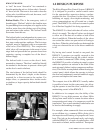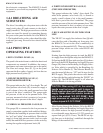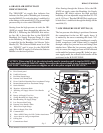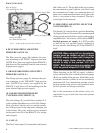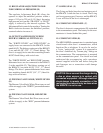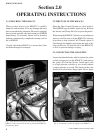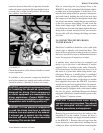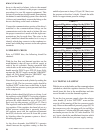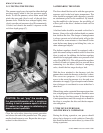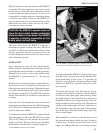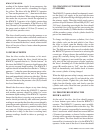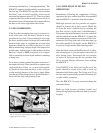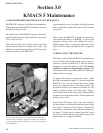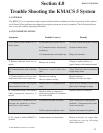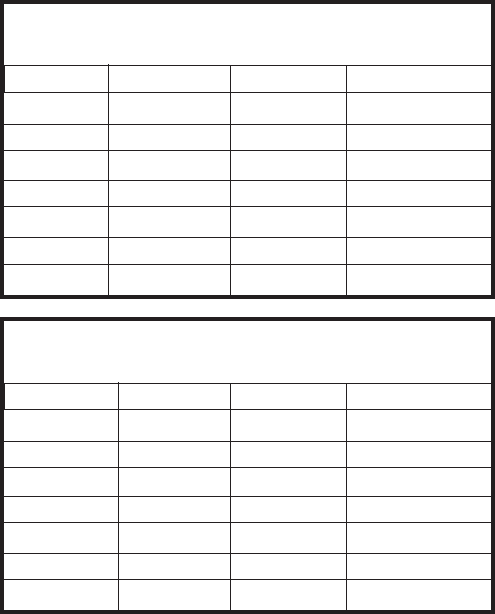
10
KMACS 5 MANUAL
© 2003 KMDSI Document # 041112001
hoses to the mask or helmet, (refer to the manual
for the mask or helmet for the proper connection
procedures for your life support equipment). This
action will prevent any foreign matter from entering
the helmet or mask breathing system. Once the hose
is blown out, immediately connect the fitting on the
hose to the fitting on the mask or helmet.
Connect the communications portion of the diver’s
umbilical to the communications fittings on the
communicator and to the mask or helmet. Be sure
the proper connection is made with the right com-
munications line for each diver. The wires in the
diver’s umbilical should be marked so it is easy to
identify which plug connects to the earphone ter-
minals and which plug connects to the microphone
terminals.
2.5 PRE-DIVE CHECK
Prior to EVERY dive, the following should be
checked:
With the free flow and demand regulator on the
mask/helmet(s) shut off, turn on the air supply at
each of the air cylinders. During operation with
scuba bottles as the main supply, the selector valve
handle must be FULLY up or FULLY down. Fully
up turns the “BLUE” supply on and the “ORANGE”
supply off. Fully down turns the “ORANGE” sup-
ply on and the “BLUE” supply off.
Note the air pressure in each cylinder by reading the
gauges (L,M). The low pressure supply should be
switched “OFF” at the source at this time. A check
valve in the low pressure system prevents back flow
to the compressor.
Both cylinders should be full prior to diving. Load
the regulator on the KMACS 5 using the regulator
adjustment knob (H). Observe the umbilical hose
pressure (B) which should be set at 150 psi (10.3
bars) over top side pressure, or 165 psi (11.5 bars)
The regulator used in the KMACS 5 is a non-vent-
ing regulator. If the regulator has been left set at a
higher pressure setting than is presently desired,
the operator must turn the regulator adjustment
knob (H) clockwise and vent air from the system
by bleeding either the pneumo system or diver’s
breathing apparatus.
As the diver descends, the KMACS 5 operator
should increase the regulator setting so that the
umbilical pressure is always 150 psi (10.3 bars) over
the pressure at the diver’s depth. Consult the table
below for approximate pressure settings.
TABLE 1
Suggested Regulator settings for the KMACS 5
Depth - fsw Pressure Optimal Minimum
0’ 14.7 psia 150 psig 150 psig
33’ 29.4 psia 165 psig 150 psig
66’ 44.1 psia 180 psig 150 psig
99’ 58.8 psia 195 psig 160 psig
132’ 73.5 psia 210 psig 175 psig
165’ 88.2 psia 225 psig 190 psig
198’ 102.9 psia 225 psig 205 psig
TABLE 1, Metric
Suggested Regulator settings for the KMACS 5
Depth-Meters Pressure Optimal Minimum
0 1 bar 10.3 bars 10.3 bars
10 2 bars 11.4 bars 10.3 bars
20 3 bars 12.4 bars 10.3 bars
30 4 bars 13.4 bars 11.0 bars
40 5 bars 14.5 bars 12.1 bars
50 6 bars 15.5 bars 13.1 bars
60 7 bars 15.5 bars 14.1 bars
2.5.1 TESTING L.P. SUPPLY
With the air on at the bottles and the communications
switched on, check the regulator function. The diver
should insert his face in the mask/helmet and take
several breaths to test the demand regulator.
To test the low pressure supply, place the selector
valve handle (I) in the “H.P. OFF” zone and the
console will be running off the low pressure supply
only. Observe the umbilical pressure gauge (B). As
the compressor cycles, the gauge will rise and fall as
the compressor’s volume tank fills and empties. The
maximum pressure for the L.P. inlet should be 225
psi. Again, check the mask/helmet function which
will also confirm the low pressure supply routing.



